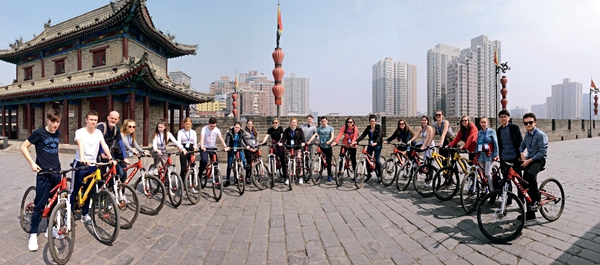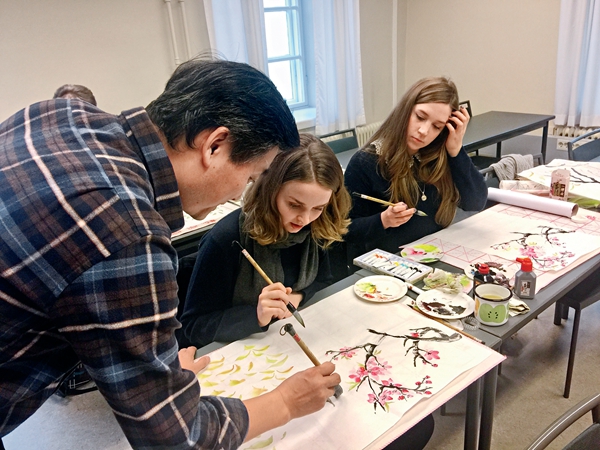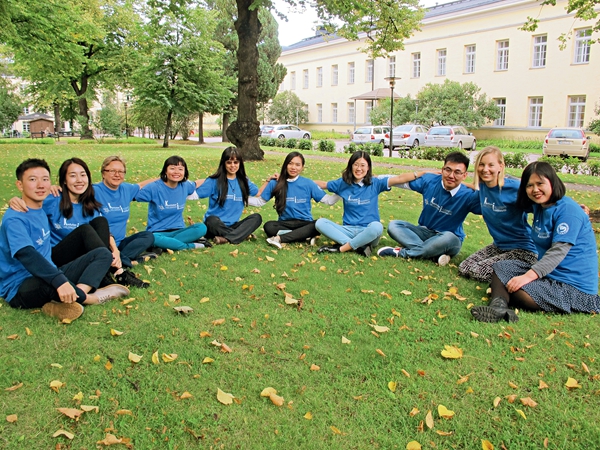By LI JIE
By LI JIE
ELIZABETH, from Ireland, is in her late 60s. She adores Chinese fiction, especially works by Yu Hua and Mo Yan. Thanks to the classes she has been taking at the Confucius Institute for almost a decade, she can read Chinese fluently. Wang Hong, the Chinese dean of the Confucius Institute at the University of Helsinki in Finland, teaches her current course. “Elizabeth never misses any classes and is passionate about learning Chinese,” Wang Hong said of her student.
Elizabeth is no exception. “The students in my class include young women whose style of dress reflects their fascination with China, a Finnish girl whose main pastime is Chinese calligraphy, which she executes beautifully, and seniors who have been studying for many years.” Wang Hong is somewhat bemused at this phenomenon, but nonetheless gratified that, “These students are truly obsessed with learning Chinese.”

Along with teaching Chinese language and calligraphy, and giving classes on traditional Chinese poetry and opera, the tens of thousands of personnel, like Wang, who work abroad at Confucius Institutes also answer specific questions about Chinese culture, and social issues. These include, “Why do some Chinese children wear open-crotch pants?”, “Why are the Chinese so keen on soup?” and “What is the Chinese government doing about the smog?”
The 511 Confucius Institutes, 1,073 Confucius classrooms and their 2.1 million attendees in 140 nations have made Confucius Institutes as a whole a bridge-builder and medium for East-West cultural exchanges. They tell the world about China and enhance friendship and cooperation between China and other countries.
Born of “Chinese Fever”
“Ms. Li, how do you distinguish among big-seal, small-seal, and clerical script styles of Chinese calligraphy?” was the question Li Yiqi, a volunteer in the Confucius Institute at University College Dublin (UCD), was asked during a Chinese language lesson. Li was astounded. The student who asked the question, a retired man in his 60s, was doing research for his book on the evolution of Chinese characters, and could not wait to share his opinions with Li.
Some students always carry with them the “300 Tang poems,” and engage Li in discussion whenever they have the chance. This enthusiasm for learning the Chinese language acquainted Li, who got her master’s degree in China, with the Chinese language learning boom in Ireland. Some young women in their teens even asked Li how they could buy TF Boys – a popular Chinese band – merchandise. Her class also celebrates any birthdays among them by singing “Happy Birthday” in Chinese. It would seem that China’s popular culture is permeating the daily life of Irish youth.

In Ireland, Confucius Institutes have achieved coverage of all age groups including students at kindergartens, primary and secondary schools, universities, and community colleges. More than 5,000 primary and secondary school students attend Chinese lessons every year. The Confucius Institute at UCD also provides materials for the weekly broadcast of the “Hello, China” radio show.
Courses at the Confucius Institute at the University of Helsinki where Wang works have expanded from basic language learning to multidimensional content, such as China media language and Chinese culture. Some of Wang’s students go on to become teachers of Chinese at local schools after graduating, so propagating the impact of the Confucius Institute.
More than a decade ago, when products made in China were seen in households throughout the West, Chinese language, as well as the culture and society behind these products, drew global attention. This led to the establishment of the first Confucius Institute. Benefiting from the U.K., France, Germany, and Spain’s experience of promoting their national languages, in 2004 China began its own exploration through establishing non-profit public institutions. Named Confucius Institutes, they aim to promote Chinese language and culture in foreign countries.
As regards the guiding principle of Confucius Institutes, the “Constitution and By-Laws of the Confucius Institutes” states: “Confucius Institutes devote themselves to satisfying the demands of people from different countries and regions in the world who learn the Chinese language, to enhancing understanding of the Chinese language and culture by these peoples, to strengthening educational and cultural exchange and cooperation between China and other countries, to deepening friendly relationships with other nations, to promoting the development of multiculturalism, so to construct a harmonious world.”
Global Layout
“Confucius Institutes have developed at a rate beyond our expectations,” said Xu Lin, the former chief executive of the Confucius Institute headquarters. The Ministry of Education initially planned to set up 100 Confucius Institutes worldwide within a decade.
To the surprise of all concerned, 46 Confucius Institutes were built around the world the first year, and the number reached 100 the year after. After 12 years, there are now 511 Confucius Institutes in 140 nations across five continents.

The development pattern of Confucius Institutes has extended far beyond basic Chinese language teaching. Originally an associate professor of the English Department at Renmin University of China, Wang has been Chinese dean of the Confucius Institute at the University of Helsinki since 2014. This has entailed teaching Chinese language and holding Chinese-culture-themed activities with Chinese teachers and volunteers; also inviting Chinese scholars to Finland to give lectures and exchange ideas. Finnish students are also encouraged to study in China.
“Chinese language teaching is our foundation, cultural activities expand our impact, and academic activities draw the attention of more scholars and intellectuals to China.” After two years’ experience, Wang is clear about the purpose of her work.
Although one constitution applies to all Confucius Institutes, conditions vary in different countries. So what should the Confucius Institutes do? Integrating and being welcomed into the local community is a test for each one. In the process of teaching, her unfamiliarity with the local culture has at times put Wang in embarrassing situations. Practice has resolved this problem. Owing to Finland’s high altitude, and low temperatures and short daylight hours in winter, cultural activities at the Confucius Institute at the University of Helsinki focus on sunshine and warmth. And because of the generally introverted nature of the Finnish people, the Confucius Institute gives rein to students’ strengths by laying emphasis on the teaching of Chinese writing.
Li was responsible for teaching a children’s Chinese language class in Ireland. Their first impressions of China came almost entirely from her descriptions. But she gradually realized that simply emphasizing the “importance” or “meaning” of the teaching content did not register with them. They became far more engaged through contact with and use of specifically Chinese items such as opera masks, shuttlecocks, and paper fans. “Interest is the key to arousing in children their spirit of exploration,” Li said. “They most enjoy finding out about Chinese culture and life through such activities.”
In 2016, to meet local demands, over 240 Confucius Institutes in 78 countries throughout the world instituted Chinese culture-related courses such as traditional Chinese medicine and Tai Chi. Confucius Institutes that specialize in textiles, dance and performance, music, food and tea culture have also been globally set up. Adjusting to local conditions is the way for each Confucius Institute to take root and gain development in its host country.
Firm Steps Override Doubts
As dean of her Institute, public relations are integral to Wang’s work. Although full of trepidations when she first arrived, after gradually finding her way Wang has won recognition and praise from local participants. “Their take on the actual situation is what really counts,” she said.
When Confucius Institutes were first established, fears were sometimes voiced based on the so-called “China threat” theory. Over the past three years, Confucius Institutes at the University of Chicago, University of Pennsylvania, and Stockholm University have successively shut down. The international community has become a breeding ground for rumors and controversy about Confucius Institutes in this regard.
Wang wholeheartedly rebuts such rhetoric. In fact, the procedure for establishing a Confucius Institute requires a foreign university or relevant educational institution to first apply to the Confucius Institute headquarters. Upon receiving approval, the local and Chinese parties jointly run the institute. The Chinese dean is responsible for Confucius Institutes under their governing Council, and both Chinese and foreign deans are jointly in charge of the Institute’s daily operations and management.
It is generally the foreign dean who raises demands, and the Chinese contingent that offers cooperation and support. Take academic activities as an example. The two parties jointly decide on activities and invite researchers specializing in topics relating to China or East Asia to present their views and hold academic debates. Teachers of Chinese language and culture classes – fundamental courses at Confucius Institutes – do their utmost to teach students the most effective learning methods, and to present a multidimensional image of Chinese society.
“The so-called ‘China threat’ theory is a false proposition,” Li said. Nobody takes it into consideration in their actual work. As teachers and volunteers assigned from China, Wang and Li must do their best to accomplish their teaching plan and at the same time hold various cultural activities. As they are apart from their families, they devote all their time to their work at the Institute, yet still feel there are not enough hours in the day. “These rumors themselves perhaps reflect the general misapprehensions about China,” Li said.
“Confucius Institutes are a bridge to the Chinese language and culture, as well as providers of learning resources.” Li believes that Institutes enact an irreplaceable role, because they offer face-to-face, experiential learning. Interaction between workers at Confucius Institutes and people in local communities evokes a tangible, touchable China.
After reading a newspaper article arbitrarily attacking Confucius Institutes, Wang’s Finnish colleague showed it to her and angrily refuted its content. Wang just laughed it off, remarking that all we can do is to mind our own business, as people who understand us know what we have really done.
Next Crossroad
“Confucius Institutes have now reached a crossroad. We must seriously consider how they are going to develop and what kind of path we should take.” This was the comment Xu made on the development of Confucius Institutes after a review of the past decade.
According to the Confucius Institutes development plan, their global layout will be basically completed by 2020. This will entail unifying quality standards, test certifications, and the appointment and training of teachers; realizing multilingualism and broad coverage of international Chinese language textbooks; establishing a wide-ranging global Chinese language and culture communication system with comprehensive functions, and making Chinese one of the languages learned and spoken widely throughout the world.
Teaching staff are integral to the future development of Confucius Institutes. At present, these teachers are mainly professionals and volunteers assigned from China. All, including Chinese deans, sign contracts valid for one to four years. Most return to their original posts in China when they finish their overseas assignments. Then groups of newly-selected teachers go to Confucius Institutes around the world.
During her two-year posting at the Confucius Institute, Wang has witnessed two shifts of volunteers and many other staff rotations. “This actually increases the difficulties in our work,” she said. Every group of workers needs training in order to be familiar with the work right from the start. Li has returned to China after finishing her one-year voluntary work, and felt reluctant to say goodbye when the time came to leave. “Just as I started to feel attuned to the work there, I had to leave. I knew and had achieved a rapport with all my students. But a new teacher needs to start from the very beginning while carrying on with the teaching plan. This is a challenge for both teacher and students,” she said.
Localization of teachers has been frequently mentioned over the past two years in connection with the development of Confucius Institutes. However, taking Finland as an example, no more than 10 Finnish teachers hold local Chinese teaching certification. Localization is hence a long-term, complicated project. “At the moment at least, it’s a difficult proposition,” Wang said. Guaranteeing the quality of assigned teaching staff, therefore, seems a particularly important task.
Wang has lately been pondering another matter. She hopes to provide educational and consulting courses for local enterprises in Finland, so forging more links between the Confucius Institute and the local community. This will, at the same time, make more funds available, something that is also relevant to the future sustainable development of Confucius Institutes.
LI JIE is a reporter with People’s Daily Overseas Edition.